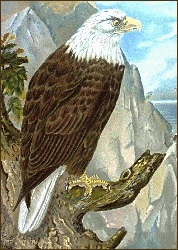 Well known as America’s national bird, the bald eagle is instantly recognizable with its white head and tail, brown body, hooked yellow beak and yellow eyes. The bald eagle is a large bird with an average wingspan of 86 inches. Nests are usually placed on cliff edges, rock pinnacles, large trees or snags. A bald eagle’s diet consists mainly of fish, sometimes making up to 90% of its diet. When a Bald Eagle is not fishing, it will feed on almost anything it can catch.
Well known as America’s national bird, the bald eagle is instantly recognizable with its white head and tail, brown body, hooked yellow beak and yellow eyes. The bald eagle is a large bird with an average wingspan of 86 inches. Nests are usually placed on cliff edges, rock pinnacles, large trees or snags. A bald eagle’s diet consists mainly of fish, sometimes making up to 90% of its diet. When a Bald Eagle is not fishing, it will feed on almost anything it can catch.
The U.S. Fish and Wildlife Service first listed the bald eagle as endangered in 43 states and threatened in five others on February 14, 1978. On July 12, 1995, the Service reclassified the bald eagle from endangered to threatened in the lower or contiguous 48 states. The bald eagle was removed from the endangered species list on July 9, 2007 after their populations had recovered sufficiently. In March 2008, bald eagles in the Sonoran Desert of central Arizona were reclassified as a distinct population segment of limited size, and once again labeled as “threatened” under the Endangered Species Act.
The Bald and Golden Eagle Protection Act (Eagle Act) continues to protect eagles and prohibit their disturbance everywhere in the U.S. to prevent future population declines. In addition, the American Eagle Foundation is dedicated to protect the majestic Bald Eagle and its habitat by supporting and conducting eagle and environmental recovery and education programs. Likewise, the non-profit Raptor Resource Project specializes in the preservation of falcons, eagles, ospreys, hawks, and owls by monitoring and maintaining their nest sites.
Decorah EagleCam: http://www.ustream.tv/decoraheagles
EagleCrest Cam: http://www.ustream.tv/eaglecresthawks
Click here to print a Bald Eagle coloring page.